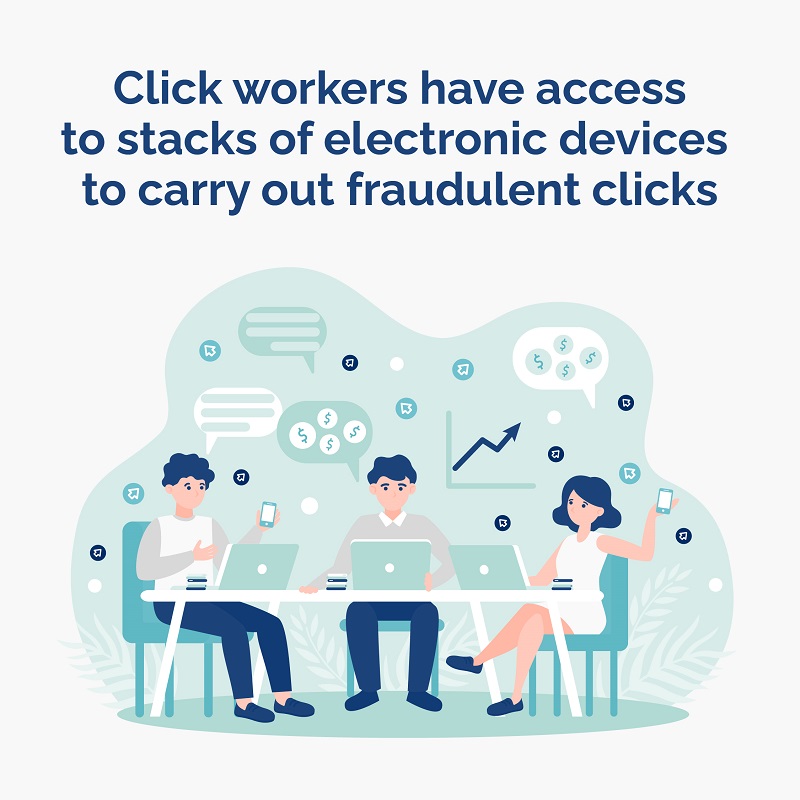The digital advertising industry depends on consumer clicks. In theory, the more ad clicks the better.
However, more clicks don’t always equal good outcomes for ad campaigns. Amongst the many ad fraud techniques used by fraudsters to produce invalid clicks, click farming is one that’s pretty long in the tooth — and its use continues to grow year on year.
Designed to produce vast amounts of fake clicks, leads, and views, click farms have the potential to destroy entire ad campaigns. In this article, we’ll explore click farms, click farming techniques, the threats they pose, and how you can detect and prevent their damaging effects.
What is a click farm?
Click farms consist of large groups of exploited, low-paid workers who manually click on online ads, usually via mobile devices, in order to increase the clickthrough rate value, boost engagement metrics, and inflate impressions. They are usually found in China, India, Indonesia, Bangladesh, and the Philippines. The video below highlights click farms in China and how they look in practice.
Click farm workers don’t just click on a few ads here and there, but they perform fraudulent clicks in their thousands. And since click farms are made up of real people clicking on ads, these clicks can appear legitimate and are more difficult to detect. Plus, workers are able to mimic real user behavior by spending time on a website before clicking an ad or filling out forms. All this, of course, means click farms have the very real potential of draining ad budgets in the blink of an eye.
Click farms are generally used to carry out the following types of fraudulent behavior:
- Performing repetitive click-based tasks (such as click on ads)
- Clicking ‘like’ and ‘follow’ on social media platforms to generate ‘engagement’
- Generating website traffic
An offshoot of click farms, lead farms are used to perform lead generation fraud by filling out forms with randomized information. This practice is usually more targeted and performed on a minor scale.
View farming is another branch of click farming, whereby workers target video ads (such as YouTube ads) at a high volume to obtain financial compensation.
Are click farms illegal?
Unfortunately, and despite click farms’ direct responsibility for committing click fraud, they are not as of yet illegal.
Since click farm workers are technically visiting websites, and are literally clicking on ads (as opposed to bad bots and botnets that mimic human behavior), the issue of click farms remains a grey area in many countries. Plus, since the majority of click farms are located in countries with very little in the way of labor laws and low wages, most click farm prevention is centered around employee working conditions and human rights abuses.
What techniques are used in click farming?
Generally, click farming techniques are very simple. Low-paid workers manually click on ads in order to drain ad budgets. Stacks of electronic devices are laid out for workers, giving them easy access to switch devices when necessary.
Many operations involve the use of mobile devices and SIM cards that can be used to create custom profiles modeled on specific demographics. For example, if a click worker is instructed to click on an ad that is mainly targeted towards men between 20-30 years of age whose hobby is running long distances, then this target market ‘profile’ can be created on a device to avoid detection. They’re able to create these profiles by browsing websites to collect cookies, and searching for certain keywords to build a profile around specific user intent.
Click workers can easily switch between different accounts depending on the ad they’re targeting.

Click farms also use VPNs and proxy traffic to hide their geographies and bypass campaign location rules, since advertisers in certain regions — such as the U.S. — typically offer higher financial rewards on PPC campaigns.
Since the phones are real and most of the actions they perform require manual interaction, both of these methods allow click farmers to hide in plain sight.
How to detect and prevent the effects of click farming
The most common vehicle of click fraud is not a human “farmer,” but usually humans working behind software to commit ad fraud. Fraudsters choose the former option since they stand to win higher financial rewards, even though the chances of detection are more likely.
Click farms are one of the easiest ways to commit click fraud, but they’re also one of the hardest to detect and therefore prevent. Mimicking human behavior is a lot more difficult to detect with common methods of fraud detection since it’s harder to pinpoint as invalid.
Typically, click farms are detected by identifying interactions with the same telemetry. Since most devices share telemetry that is highly unlikely to be repeated in such large numbers (for example, the same network speed across devices, IP addresses, browser versions, and phone models, etc), click farm clicks can be spotted. Identifying click farm activity manually is incredibly arduous and simply put, not feasible in a fast-paced digital ad world.
Preventing click farm activity, therefore, requires an approach that can accurately identify fraudulent human traffic that goes beyond blocking IP addresses — namely, dedicated anti-fraud solutions.
At Opticks, our solutions capture telemetry at network, application, and user level to create a comprehensive set of valuable data about each visit to determine whether the activity is legitimate and malicious. This data is then analyzed using proprietary machine learning analytics, blocking fraudulent traffic based on a risk score.
Our solutions are far more sophisticated than click farm operations and are able to detect atypical activity associated with fraudulent behavior.
Our vision of the future of click farming
One of the biggest issues surrounding click farms is the fact that they are highly scalable. Since click farm workers are exploited in countries with both low wages and low employment, finding human resources to perform click fraud is incredibly easy.
Plus, with the digital advertising industry booming, the unfortunate reality is that as your business grows, so does the profitability of targeting it for ad fraud.
However, in general, we see that the use of click farms to perform click fraud is decreasing. This is due to the fact that they cost a large amount of money to run in terms of electricity and devices, and rise in other activities such as review farming or cryptocurrency mining. Plus, given the advancement in anti-fraud solutions that can catch them early and shut them down, fraudsters continue to move their fraud schemes to data centers and other systems that can scale to an even bigger extent.
That said, click farms will still continue to operate to perform fraud that requires more complex human interaction, such as cost-per-install (CPI) or complex lead generation campaigns.
Wave goodbye to click farming with anti-fraud software
Anti-fraud solutions provide you with the safest way of preventing budget-draining clicks, and helping prevent your campaign data from being skewed by erroneous information.
Anti-fraud solution Opticks can help you prevent click farm activity and many other types of ad fraud before they have the chance to destroy your campaigns and empty your campaign budgets. Find out more about how the expert team at Opticks can help protect your advertising campaigns by contacting our expert team here for a free demo or starting your free trial.
